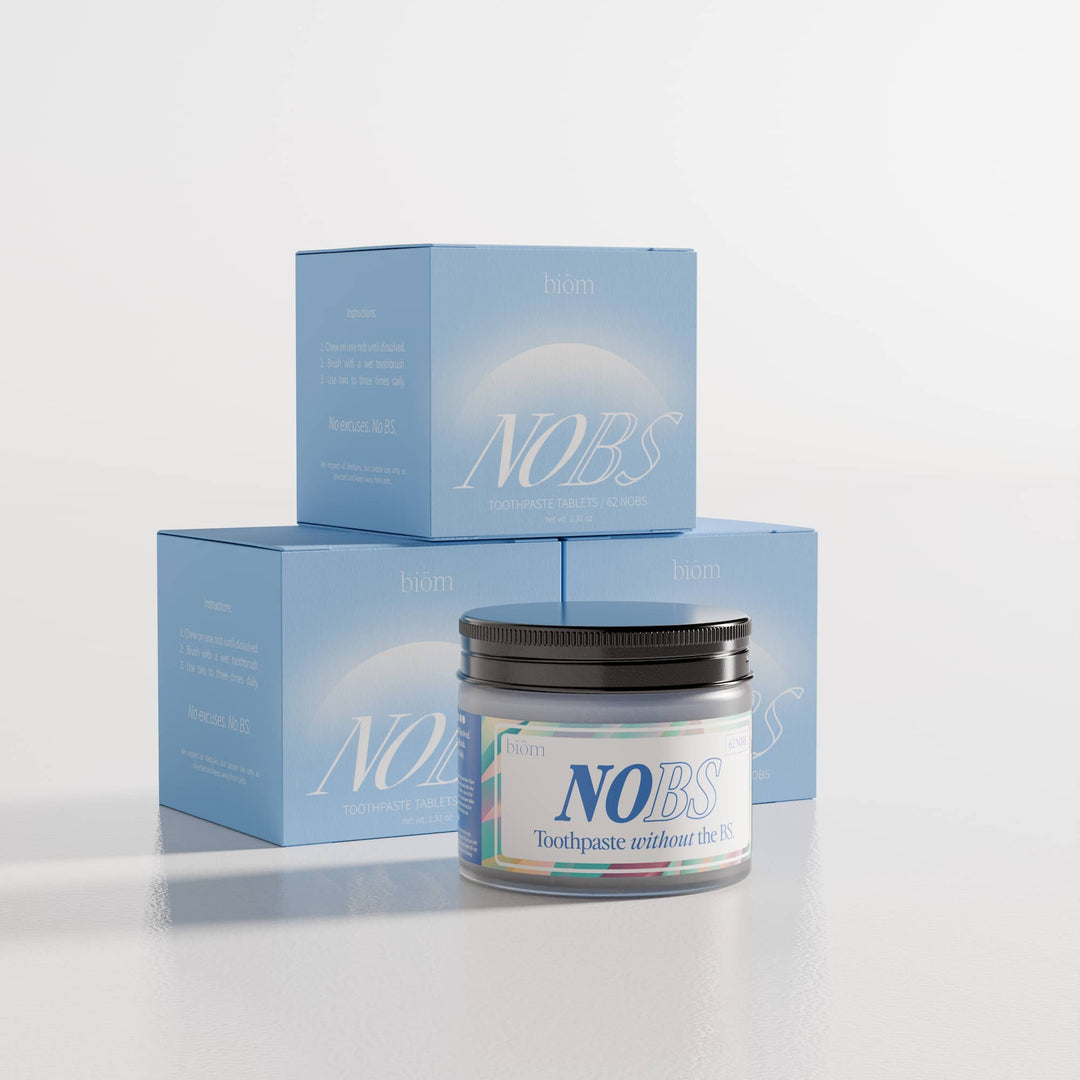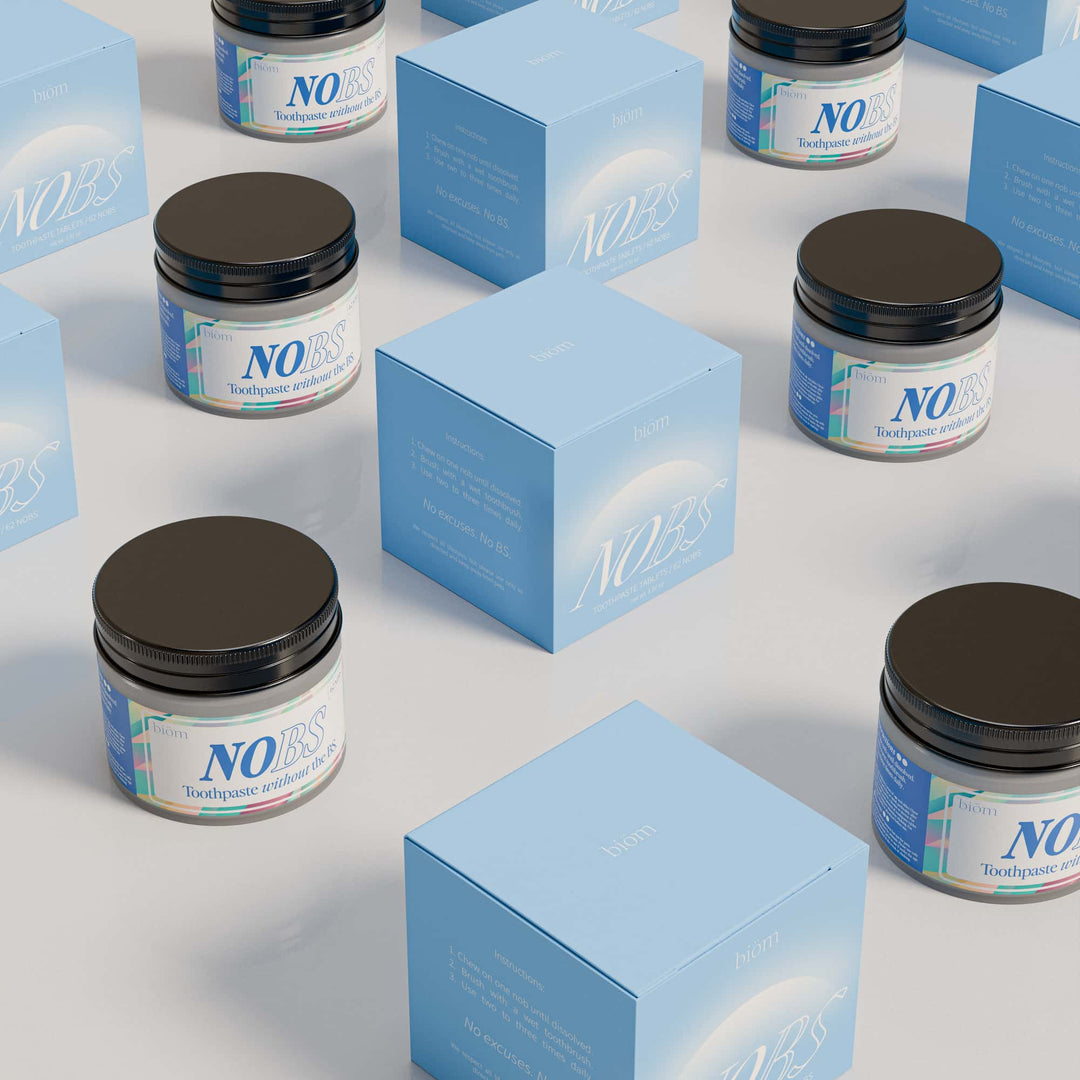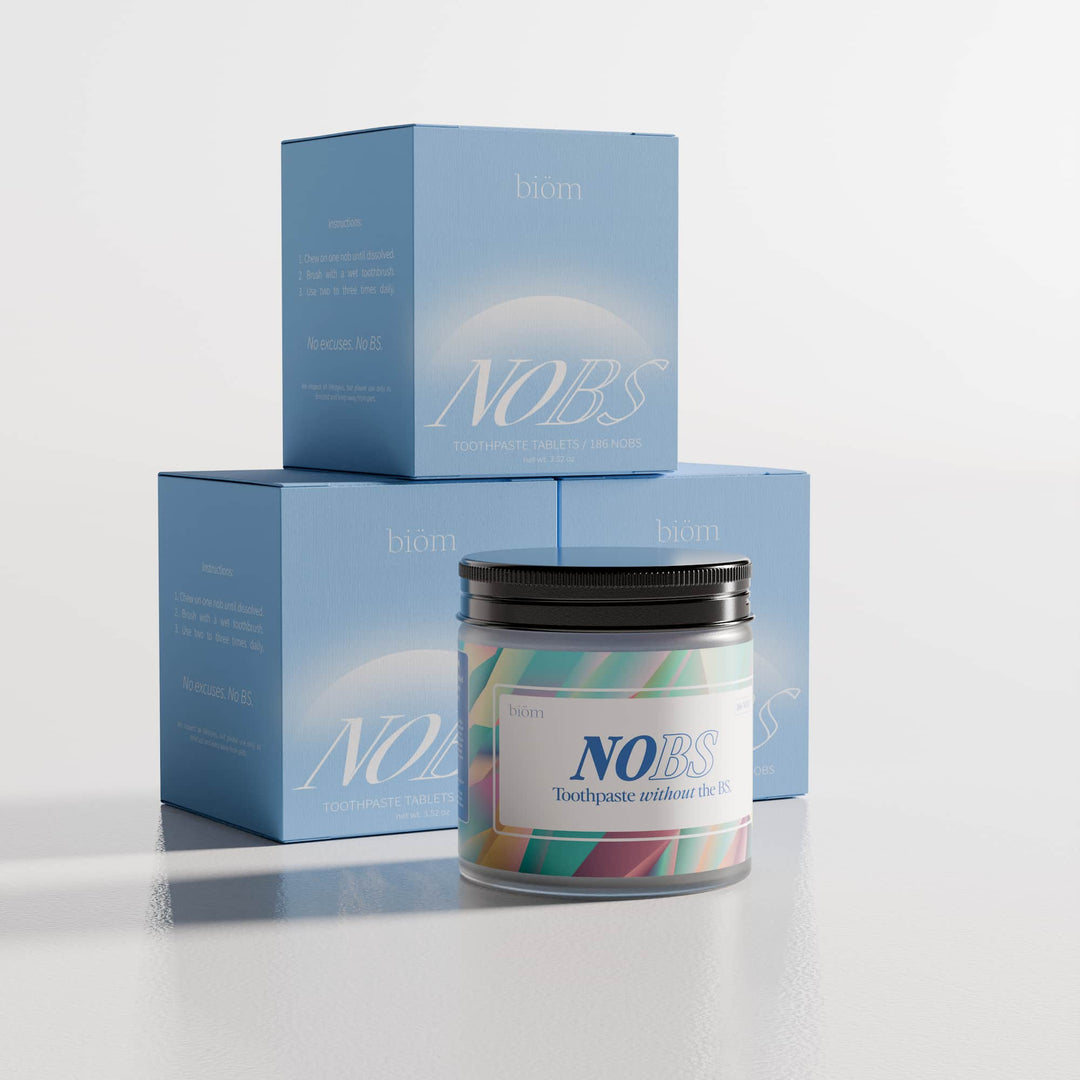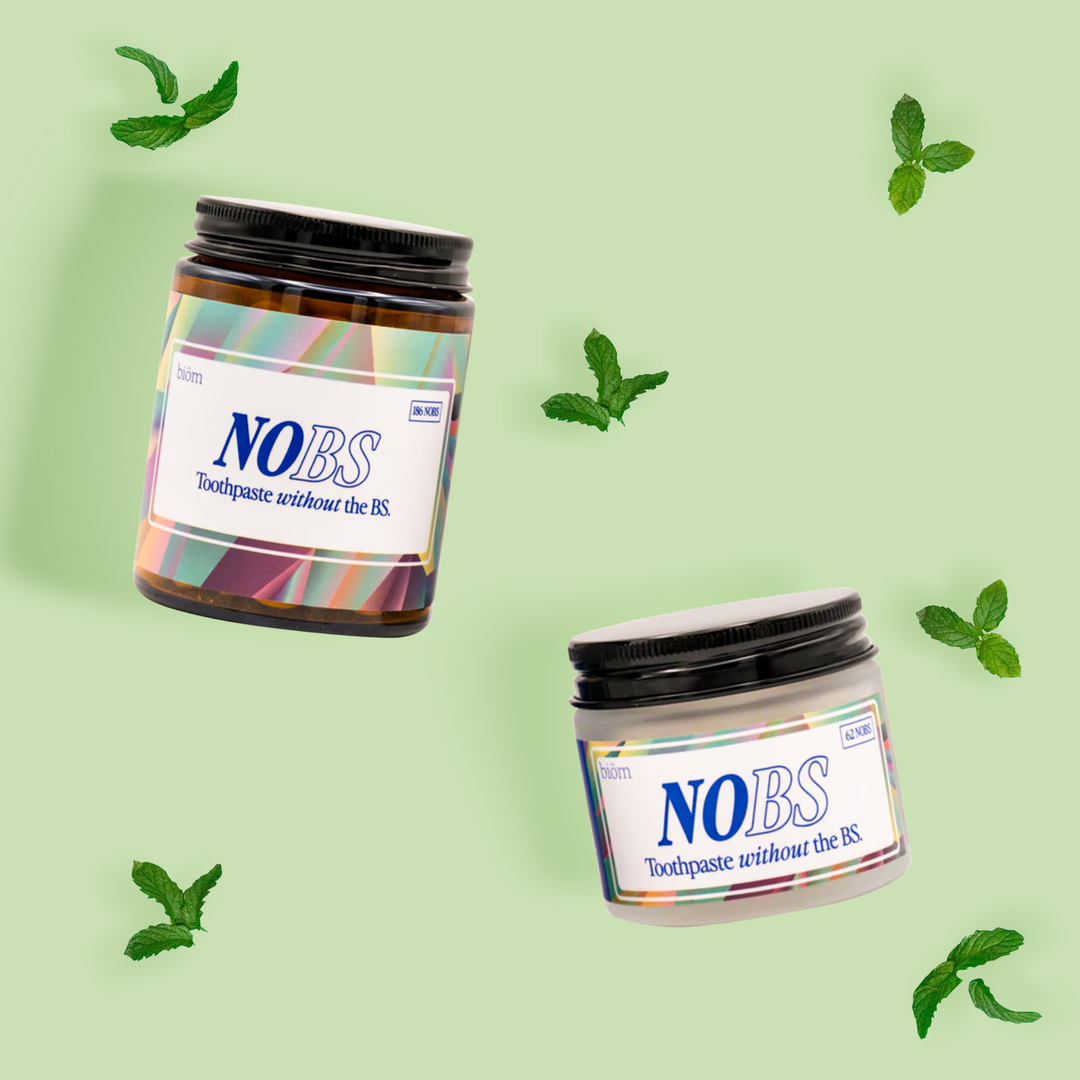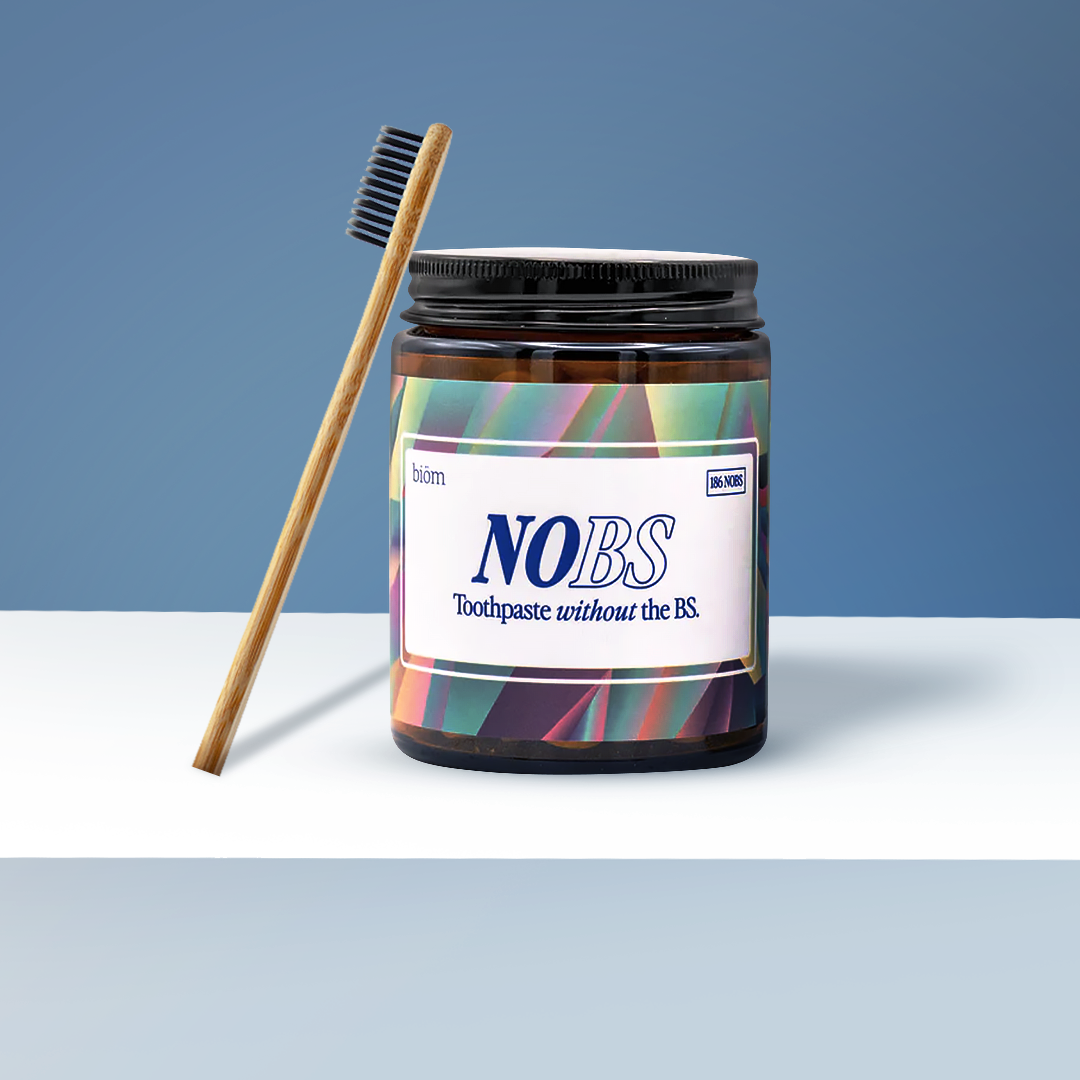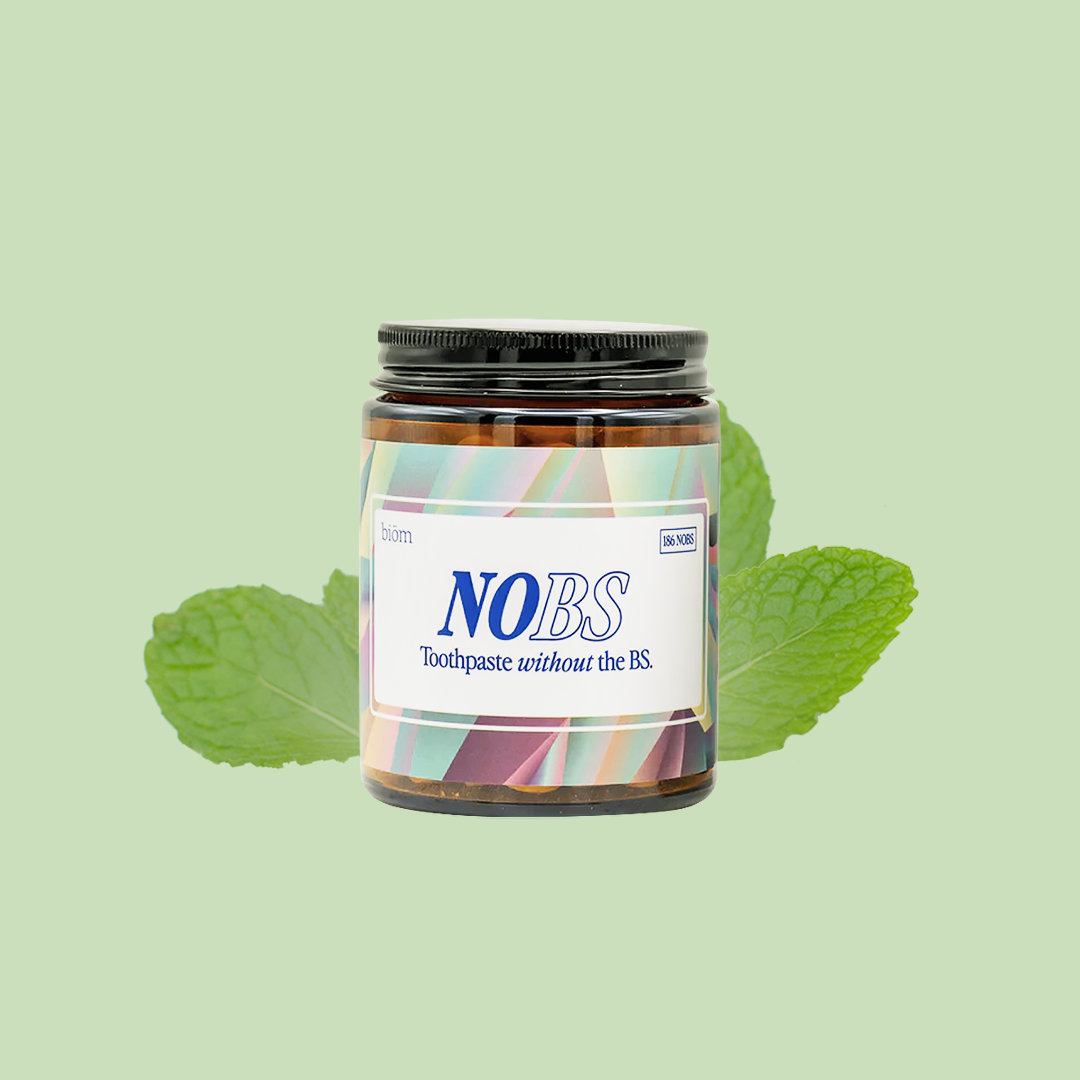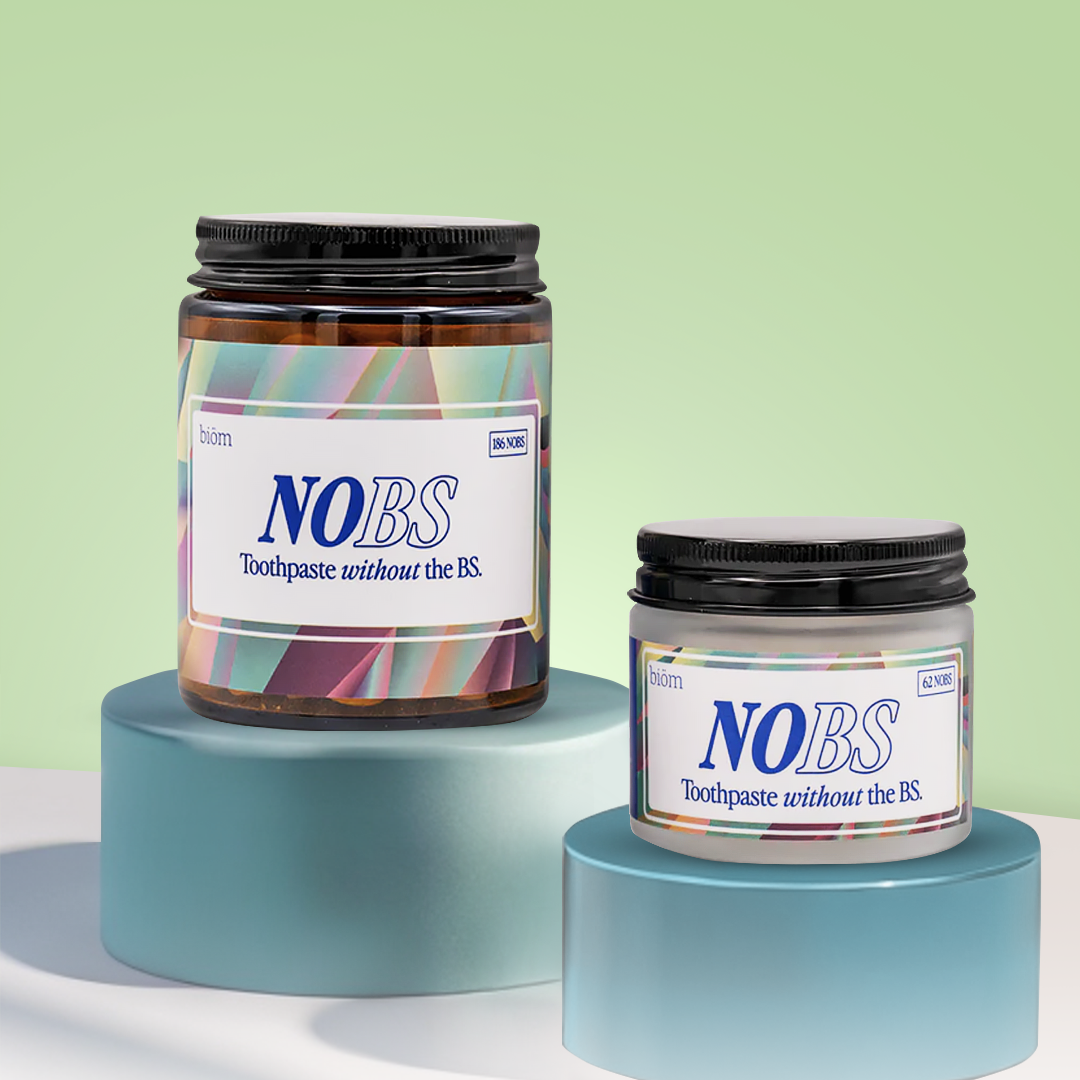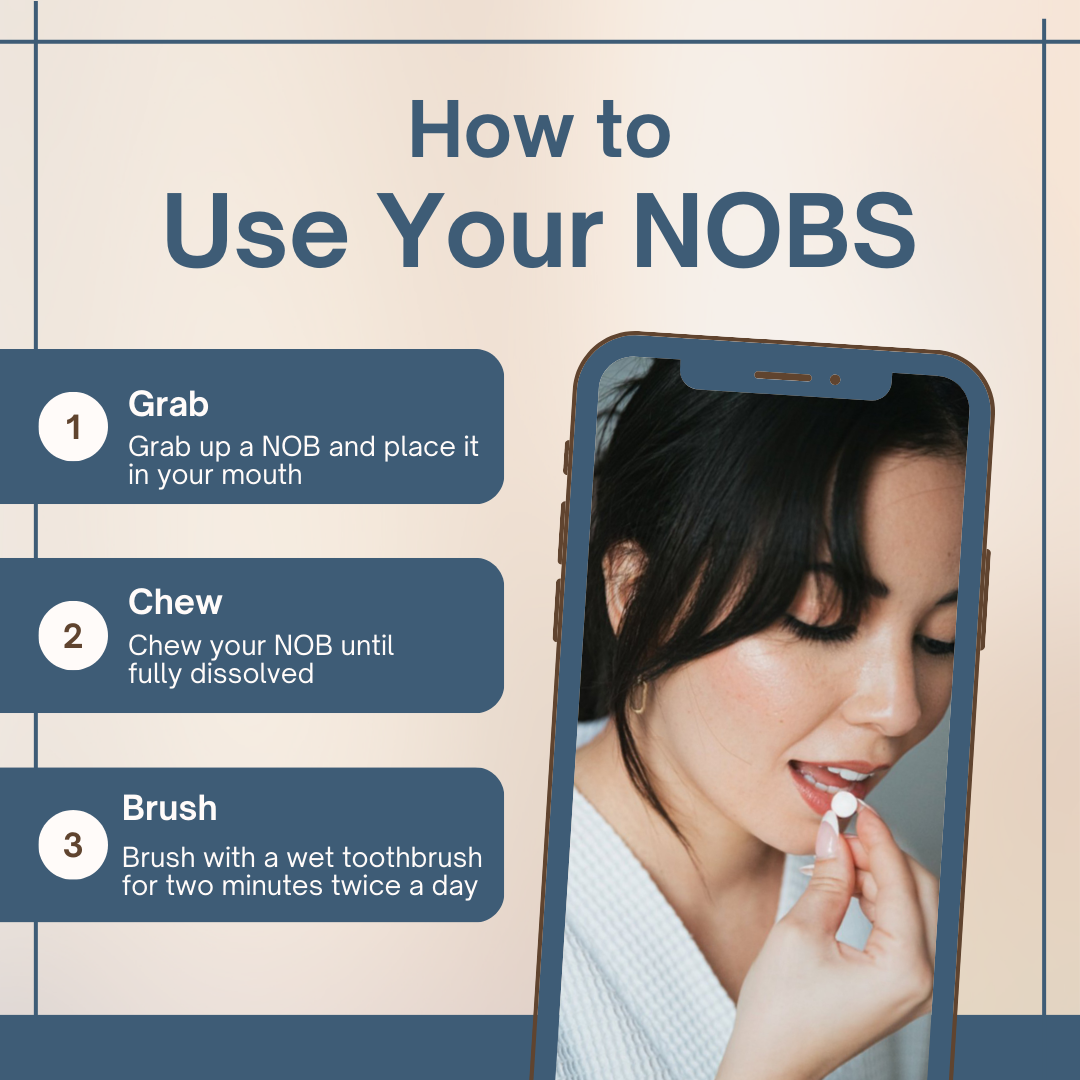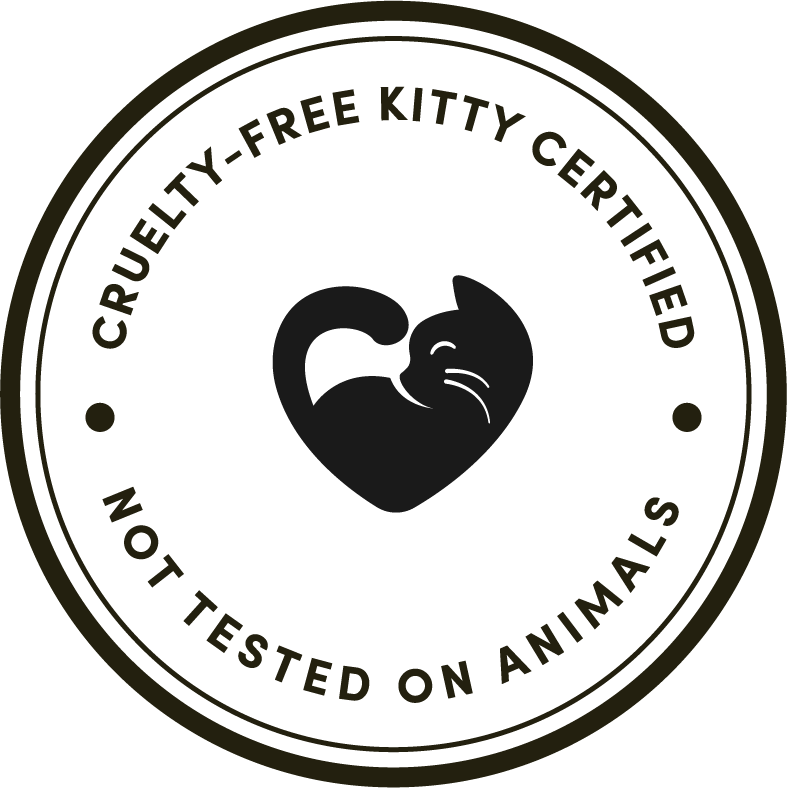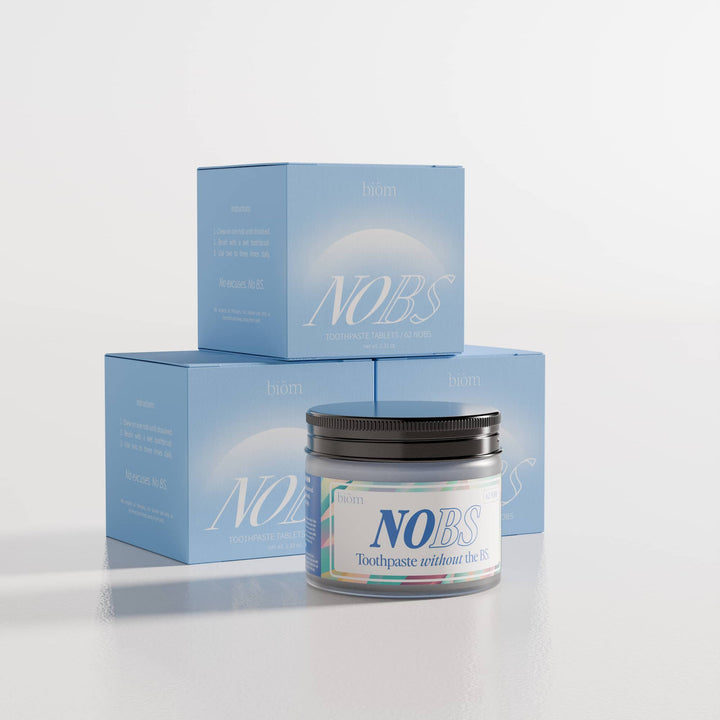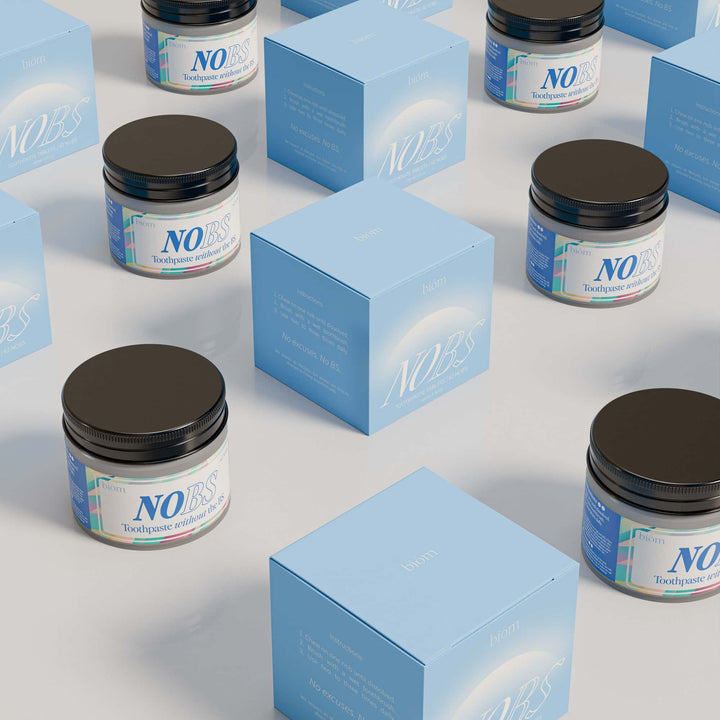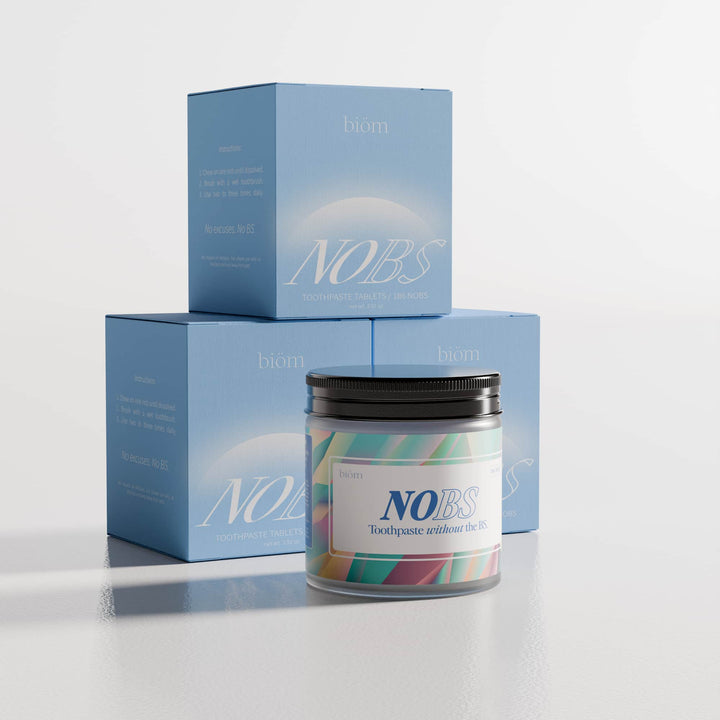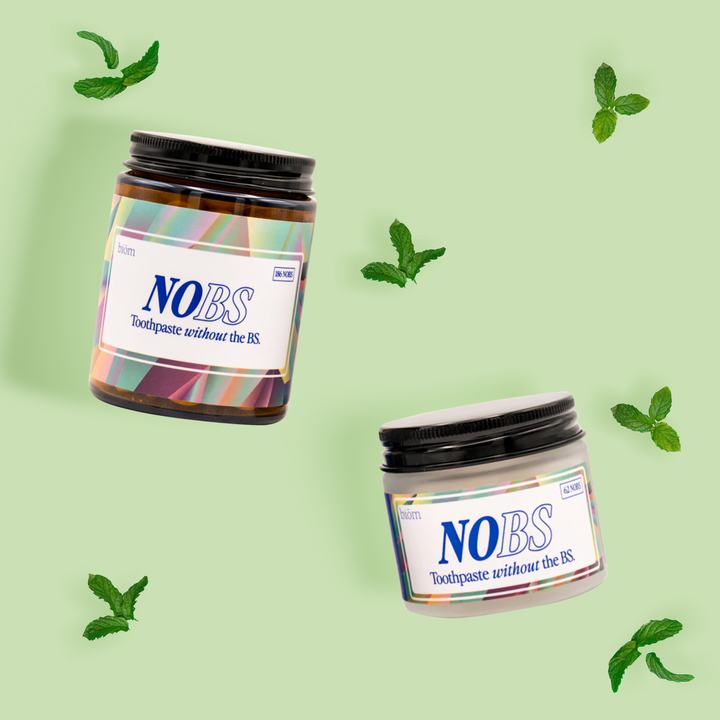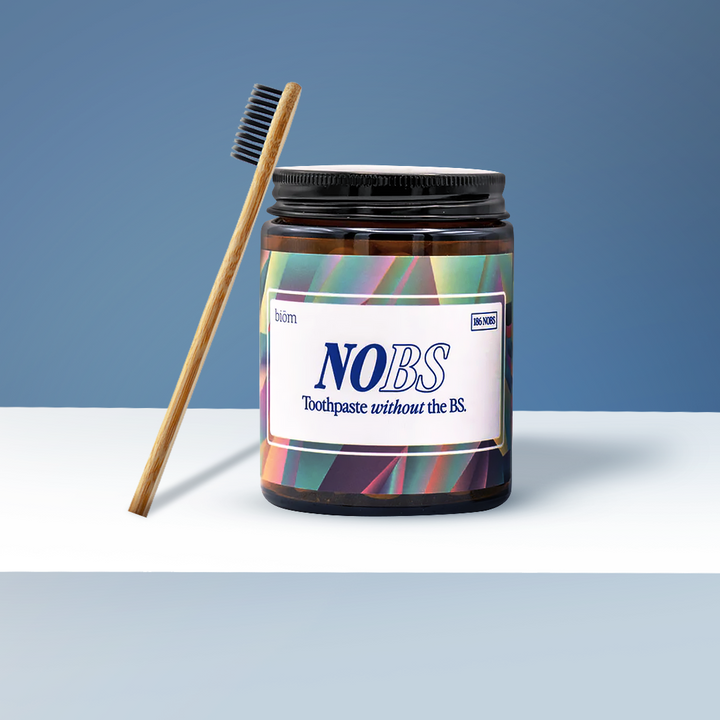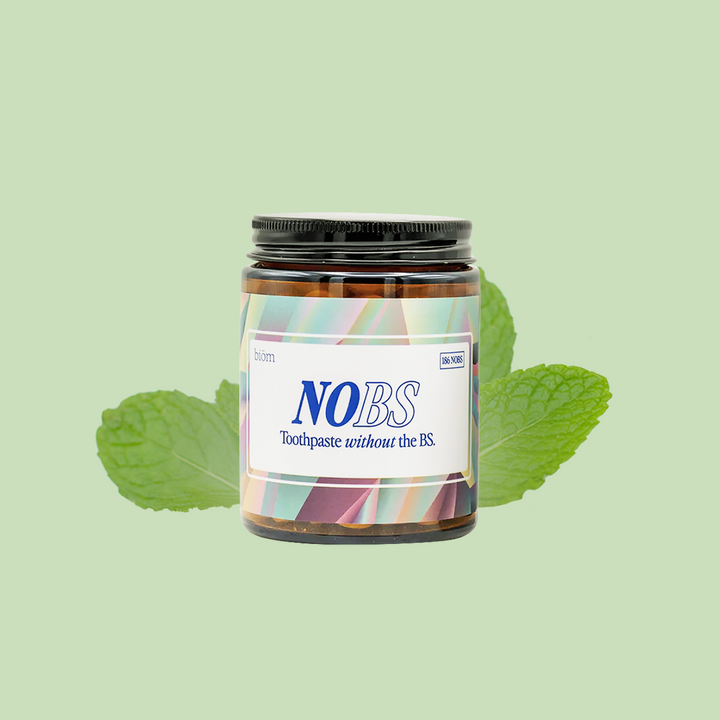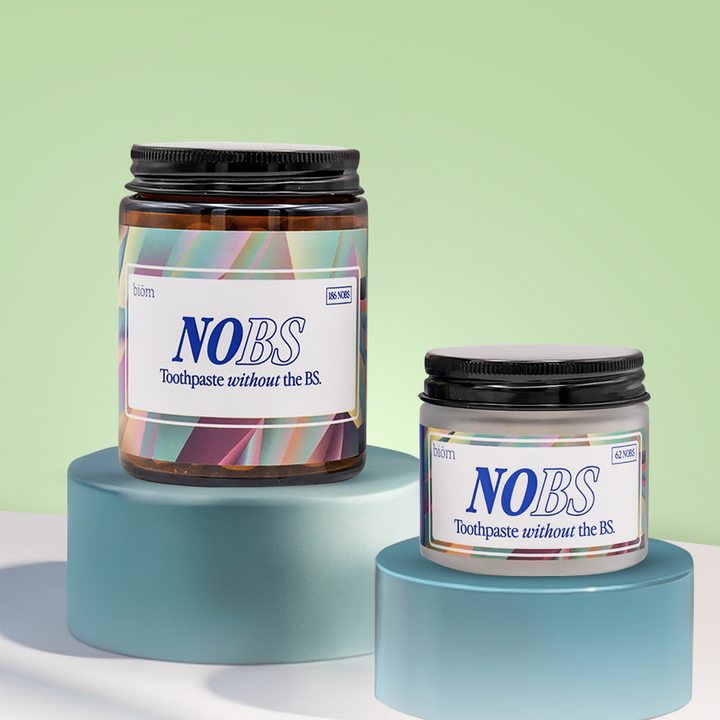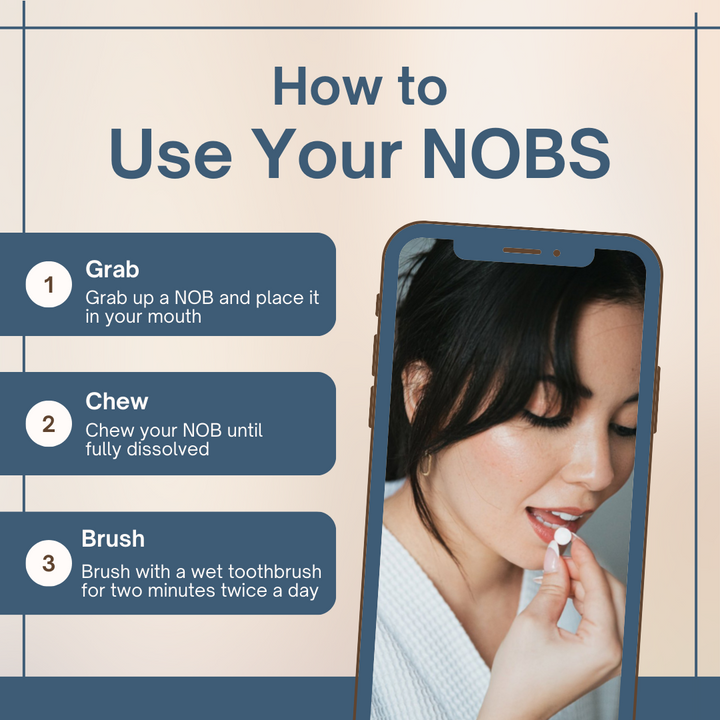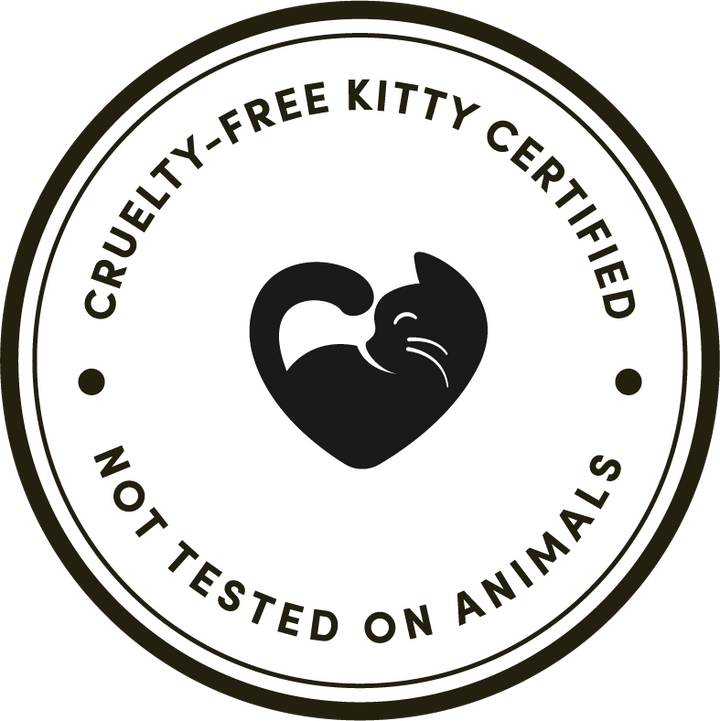What's the Deal with SLS in Toothpaste?
Sodium lauryl sulfate (SLS) is a surfactant used in toothpaste to break up surface tension and creating that nice, foamy lather we all love to brush with.
However, while it helps remove debris and food particles from the teeth effectively, SLS has raised concerns due to its potential to cause oral irritation, dryness, and sensitivity in some individuals. In fact, SLS is one of the most commonly avoided ingredients in toothpaste.
Despite its widespread use, some people prefer to avoid toothpaste containing SLS to minimize the risk of adverse reactions and maintain optimal oral health.
For this reason, some brands (like biöm!) have developed SLS free toothpastes which offer equal benefits to SLS-containing toothpastes with a reduced risk of adverse effects.
In this article, I'll explain everything you need to know about SLS in toothpaste.
What is SLS?

Sodium lauryl sulfate, also known as SLS, is a detergent, surfactant compound, and foaming agent found in many household cleaning products and personal care products, including:
-
toothpaste
-
shampoo
-
shaving cream
-
and body wash.
Its primary function is to create foam and lather, which helps remove dirt, oil, and debris from the surface being cleaned (typically either your skin or teeth). Sodium lauryl sulphate is commonly found along side of similar ingredients such as hydrogen lauryl sulfate.
In toothpaste, SLS enhances cleaning action by dispersing your toothpaste evenly throughout the mouth and reaching areas that may be difficult to access. However, SLS can also be "bad" in toothpaste, as it has the potential to strip away oral mucosa, the protective layer of saliva that coats the gums and oral tissues.
This can lead to dryness and irritation in the oral cavity, especially for individuals with sensitive gums or a predisposition to oral sensitivity. For this reason, many people are turning to SLS free toothpastes for a safer, more gentle clean.
Why is SLS in toothpaste?

SLS is commonly included in toothpaste for its surfactant properties, which help create foam and lather. This foaming action helps you distribute toothpaste throughout your mouth during brushing which allows it to reach areas that might otherwise be difficult to access.
Additionally, SLS enhances the cleaning efficacy of toothpaste by effectively removing debris, food particles, and plaque from the teeth and gums.
While SLS can be beneficial in toothpaste, some people may experience allergic reactions or increased sensitivity to SLS, manifesting as recurrent aphthous ulcers, canker sores, or a burning sensation in the mouth. Therefore, there is ongoing debate and research regarding its potential adverse effects on oral health.
Thankfully, as technology has progressed, we now have newer, more gentle surfactants that can be found in SLS free toothpastes as compared to SLS containing toothpaste.
Is SLS in toothpaste safe for everyone?
Sodium lauryl sulfate (SLS) is not ideal for everyone, especially those with sensitive mouths or recurring canker sores.
Research shows that SLS can irritate the soft tissues in the mouth, leading to discomfort for certain individuals.
SLS-free toothpaste is a safer and gentler alternative that effectively cleans teeth without causing irritation.
It’s especially beneficial for people with dry mouths, sensitivity, or allergies to harsh ingredients.
By choosing an SLS-free option, you can maintain oral health while avoiding unnecessary irritation.
Is sodium lauryl sulphate free toothpaste safe for everyday use?
Yes, sodium lauryl sulphate (SLS)-free toothpaste is safe for everyday use and is often recommended for individuals with sensitive mouths.
Studies suggest that SLS-free toothpaste can reduce irritation, particularly for people prone to canker sores or dry mouth. SLS is a common foaming agent in toothpaste, but it may cause discomfort for those with oral sensitivities.
Using SLS-free toothpaste provides effective cleaning without the harshness that some individuals experience with SLS-based products. Studies also suggest that these alternatives are just as capable of maintaining oral hygiene, as they still include essential cleaning and protective ingredients.
For those with specific oral concerns or preferences, SLS-free toothpaste is a gentle and safe option for daily br
Risks of SLS in Toothpaste

SLS in toothpaste has been associated with several potential risks. First, SLS can cause mouth irritation and dryness in individuals with sensitive gums or oral tissues. This occurs because the surfactant properties of SLS can strip away the protective layer of saliva in the mouth, leading to dryness and increasing the likelihood of irritation or inflammation. Some people may experience symptoms such as mouth ulcers, canker sores, or a burning sensation in the mouth when using toothpaste containing SLS.
Secondly, while SLS is generally regarded as safe for oral use by regulatory agencies, there is ongoing debate and research regarding its potential long-term effects on oral health. Some studies suggest that SLS may contribute to the development of recurrent aphthous ulcers (canker sores) and allergic reactions in certain individuals. Therefore, for those with sensitive gums or a history of oral sensitivity, avoiding toothpaste with SLS can minimize discomfort.
Furthermore, concerns have been raised about the potential systemic absorption of SLS through the oral mucosa, especially in individuals with compromised oral health or conditions that may increase mucosal permeability. While the extent of systemic absorption is still under investigation, the paper linked above suggests that SLS may enter systemic circulation and accumulate in various organs, raising questions about its safety with prolonged or repeated exposure.
Additionally, there is ongoing debate regarding the environmental impact of SLS, as it is not readily biodegradable and can persist in aquatic ecosystems, potentially posing risks to aquatic organisms and ecosystems.
Overall, while SLS plays a role in toothpaste, it's an outdated technology and individuals who are concerned about the potential risks associated with it can opt for SLS free toothpaste instead.
Is SLS in toothpaste bad for you?

While not necessarily bad for you, SLS can cause irritation and dryness in individuals with sensitive gums or oral tissues, potentially leading to symptoms such as mouth ulcers or a burning sensation. While regulatory agencies consider SLS safe for oral use, ongoing research explores its potential long-term effects on oral health and systemic absorption through the oral mucosa.
Consequently, many families are now turning to natural toothpaste without SLS for a gentle, safer brushing experience.
What can I use instead of SLS toothpaste?

Instead of SLS toothpaste, you can opt for SLS free toothpaste formulations that utilize alternative surfactants or foaming agents. For example, our SLS-free toothpaste tablets include natural ingredients such as coconut oil-derived surfactants instead of SLS to protect you from ulcers and mouth irritation.
Summary: What's SLS in toothpaste?
Sodium lauryl sulfate (SLS) is a common surfactant and foaming agent found in many toothpaste formulations. It is used to create the foaming action that helps distribute toothpaste evenly throughout the mouth and aids in the removal of food particles and debris from the teeth and gums.
However, some individuals may experience adverse reactions to SLS, such as oral irritation, dryness, or sensitivity, leading to concerns about its safety and suitability for use in oral care products.
For this reason, many people are turning to SLS free toothpastes with nano hydroxyapatite which are gentle enough to be used daily and can strengthen enamel and reverse tooth decay.
Frequently Asked Questions
Is SLS in toothpaste harmful?
Yes, sodium lauryl sulfate (SLS) in toothpaste has been associated with potential oral health risks. It can cause dryness and irritation of the gums, leading to discomfort or even allergic reactions in some individuals. Additionally, SLS may contribute to the development of recurrent aphthous ulcers (canker sores) and increase the risk of oral health issues over time. While regulatory agencies generally consider SLS safe for use in toothpaste, concerns persist regarding its potential adverse effects, prompting some individuals to seek SLS-free toothpastes instead.
Is SLS free toothpaste better?
Yes, SLS free toothpaste may be preferable for individuals with sensitive gums or a history of oral sensitivity. By eliminating sodium lauryl sulfate (SLS), these toothpaste formulations minimize the risk of dryness, irritation, and potential allergic reactions commonly associated with SLS-containing products. Additionally, SLS-free toothpaste options offer a gentler alternative that can help maintain optimal oral health without exacerbating existing issues or discomfort.
What are the side effects of sodium lauryl sulfate?
Sodium lauryl sulfate (SLS) has been associated with several potential side effects, including oral irritation, dryness, and increased sensitivity. It can strip away the protective layer of saliva on the gums, leading to dryness and irritation, and may exacerbate existing conditions such as canker sores or mouth ulcers. Furthermore, some individuals may experience allergic reactions or heightened sensitivity to SLS, manifesting as burning sensations or itching in the mouth. While SLS is generally regarded as safe for use in toothpaste by regulatory agencies, concerns persist about its potential adverse effects on oral health, particularly for those with sensitivities or pre-existing conditions.
Which toothpaste does not contain SLS?
Instead of SLS toothpaste, you can opt for SLS free toothpaste formulations that utilize alternative surfactants or foaming agents. For example, SLS-free NOBS Toothpaste Tablets include natural ingredients such as coconut oil-derived surfactants instead of SLS to protect you from ulcers and mouth irritation.
Is SLS cancerous?
There is no conclusive evidence to suggest that sodium lauryl sulfate (SLS) causes cancer when used in toothpaste. However, some studies have raised concerns about its potential to interact with other compounds and form nitrosamines, which are known carcinogens. While the risk of cancer from SLS in toothpaste is considered low, individuals with specific sensitivities or concerns may choose to opt for SLS-free alternatives to minimize potential risks.
Why avoid sodium lauryl sulfate in toothpaste?
You might want to avoid sodium lauryl sulfate (SLS) in toothpaste due to concerns about its potential adverse effects on oral health. SLS is a surfactant commonly used in toothpaste to create foam and aid in the distribution of ingredients, but it can strip away the protective layer of saliva on the gums, leading to dryness and irritation. Additionally, SLS has been associated with oral irritation, increased sensitivity, and allergic reactions in some individuals, which can manifest as mouth ulcers, canker sores, or a burning sensation in the mouth.
Should you avoid SLS?
Yes, you may want to avoid SLS due to concerns about its potential adverse effects on oral health, such as irritation, increased sensitivity, and allergic reactions. However, SLS is generally considered safe for use in toothpaste, and some people use toothpaste containing SLS without experiencing any negative effects.
Who should use sodium lauryl sulphate free toothpaste?
Sodium Lauryl Sulphate (SLS)-free toothpaste is ideal for individuals with sensitive mouths, recurring canker sores, or dry mouth. SLS-free toothpaste reduces irritation and discomfort caused by harsh foaming agents. It is also a good choice for those seeking a gentler option for everyday oral care.
What are the side effects of sodium lauryl sulphate toothpaste?
The side effects of sodium lauryl sulfate (SLS) toothpaste can include mouth irritation, dry mouth, or an increased risk of developing canker sores for sensitive individuals. SLS, a foaming agent, can disrupt the natural balance of oral tissues, leading to discomfort in some users. Prolonged use may also exacerbate sensitivity or irritation for those with pre-existing oral conditions.
Is sodium lauryl sulphate bad for sensitive teeth?
Yes, sodium lauryl sulfate (SLS) can be bad for sensitive teeth and gums. Studies suggest that SLS, a common foaming agent in toothpaste, may cause irritation or dryness in individuals with oral sensitivities. It can also exacerbate conditions like canker sores or increase discomfort for those with already sensitive teeth. Opting for SLS-free toothpaste is often recommended for a gentler oral care routine..
Should you use SLS free toothpaste?
Yes, SLS-free toothpaste is a good choice, especially if you have a sensitive mouth or get canker sores often. It cleans your teeth just as well but is gentler and less likely to cause irritation. If regular toothpaste makes your mouth feel dry or uncomfortable, switching to an SLS-free option can help keep your mouth healthy and pain-free.


